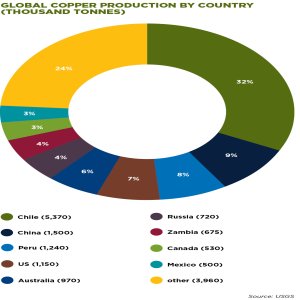Canadian Participation in Mexican Mining

Canadian Participation in Mexican Mining

STORY INLINE POST
Q: How has the relationship between Canada and Mexico developed over the past decade, and what are the main sectors that have driven this growth?
DR: The Canadian Chamber of Commerce has grown considerably over the last 31 years. In the last 10 years mining has experienced the greatest growth, but also the automotive and aerospace industries have grown substantially. We are very proud of the fact that Bombardier created the aerospace industry in Mexico, which has been a project that took 10 years. What really interests us now is to promote the supply chains to our major manufacturers and to support the Mexican government in its efforts to increase national content. We not only represent major Canadian companies, we also represent small and mediumsized companies, as well as Mexican companies that want to be part of those supply chains.
Q: How is the Canadian Chamber of Commerce currently working with the Mexican government, and what are your expectations for the Peña Nieto sexenio?
DR: We are very encouraged by the initiatives of this government and its collaboration with the legislature. We have never seen so many reforms announced in such a short space of time, initiating structural changes to the economy that in turn will stimulate foreign investment and the trade between the two countries. The changes are very encouraging for Mexican companies with Canadian capital. Canadian companies directly and indirectly employ more than 100,000 people across the country. We are here to stay.
Q: What role do Canadian companies play the development of Mexican supply chains?
DR: Our companies look for the best solution for their supply chain and the support structure for an extractive industry like mining. There is a considerable amount of Mexican content and support services involved in the building and operating of a mine; mining is labor intensive, and while equipment is an important part of the investment, I would suggest that the biggest single cost is the labor component.
Q: What triggered the mass entry of Canadian companies in the Mexican mining industry?
RW: The Canadian companies started to explore investment opportunities in early 2000, but the real boom came in 2005-2006. It was at that time that we created the Mining Taskforce within the Canadian Chamber of Commerce to support the companies with Canadian capital in Mexico. What do Canadians bring to the table? Canada has a long mining history, and as such the companies have become worldwide industry leaders. Our companies have developed new technologies, strong safety and environmental practices, as well as superior CSR programs.
DR: One other factor in Canada’s success is that we provide transparency to our investors in the mining sector – investors in the Canadian mining sector operate globally, and the legal structures, financial structures, and the oversight that they have all make it possible for Canadian companies to come to Mexico and invest venture capital. This is a really important reason why the Canadian mining sector has been so successful worldwide.
Q: What are the Mining Taskforce’s current priorities?
RW: Our key priorities at this time are the upcoming fiscal reform, as well as any potential amendments to the mining law. In order to maintain existing investment and attract new investors, competitive factors as well as the global economic situation must be taken into consideration. A new tax on mining companies that does not consider the substantial investments that have been made will have a negative impact on the companies that have already invested in Mexico and on the regions where those companies have been working. It will also redirect new investment dollars to more fiscally competitive destinations. Canadian investment in the Mexican mining industry accounts for 71% of total foreign investment in this sector, and as such our concern is that a fair and competitive tax system should be established. In addition, legal certainty and rule of law are key priorities.
Q: To what extent do you think that the industry can selfregulate its community relationships, and to what extent should they be allowed to?
RW: Many of the companies operating in the mining industry today have superior CSR and environmental practices, but you are not legislating for those players. The government has to legislate for the not so good companies, and of course there are some of those. Many of our companies have far superior standards than the NOMs require, so in a way they are already self-regulating. Canadian mining companies raise the bar in this area. Rules and regulations do not scare mining companies. The problem comes when you start to get conflict, leaving areas open that could be misconstrued and which might affect your rule of law. That is the issue. In general my experience has been that Canadian companies walk the talk. These are companies that have really integrated their code of conduct into their everyday operations. They truly believe in community relations; it is a part of their strategy, and not just a marketing document. That is a fundamental difference between the serious companies and those that may find themselves having problems.
Q: What are lessons that Canadian mining companies have learned in Mexico that can be applied in other countries?
DR: In Canada we have 10 provinces, three territories, and there are many different types of communities. In Mexico we face a similar situation but there is a better effort to understand community factors and not assume that communities are the same in different parts of the country. Canadian mining companies bring what they have learned from understanding those conditions and concerns back home. Community means a lot of different things, but it is all about being local; Mexico is very good at thinking local.
Q: The government faces a big challenge in reaching these communities and changing their living standards. Is the government interested in engaging with mining companies to take advantage of their proximity to those isolated communities?
RW: This has always been the position of the mining companies – they want to work together with the government on this to make a bigger impact. One of the opportunity areas is using the new tax to support social and economic development at the community level.
DR: Because of the remoteness of mining operations they need not only to complement but also to replace government infrastructure, due to its absence in those areas. Our mining companies and executives not only operate in but also live in those communities.
Q: How can Mexican suppliers prepare themselves to build good working relationship with Canadian companies?
DR: Canadians are concerned with meeting anti-corruption legislation (under the Corruption of Foreign Officials Act). Transparent structures and practices are essential, so that Canadian companies can review who they are and effectively vet their suppliers and partners. Bribery and corruption are taken very seriously in Canada.
Q: If you had one minute to address all of the members of Congress of Mexico, what would you like to say to them?
RW: They really need to look at the impact of any action on the competitiveness of Mexico as a mining country. When mining towns have been abandoned five years down the road it will be too late, because it will take another five or 10 years to bring those projects back in.
DR: One of the biggest threats to any major industry is the absence of investment. Our companies are heavily invested and very committed, but in the boardroom they are constantly evaluating the opportunities that are available in different countries around the world. The impact of new investment is difficult to measure until you see trend lines; suddenly you are five years down the line and it is too late.





















